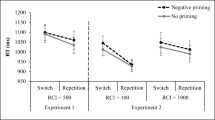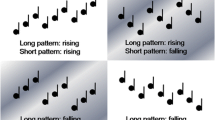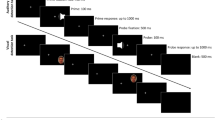Abstract.
In this paper we investigate whether an attention shift towards an auditory signal, while performing a two-choice serial reaction time task, primes responses in the direction of the auditory signal. In Experiment 1, subjects had to react to the pitch of the signal, which was randomly presented to the left or right ear. A short (50-ms) and a long (1000-ms) response-stimulus interval (RSI) was used. In Experiment 2 with an RSI of 2000 ms, subjects had to respond to the color of a centrally presented visual stimulus, while a sound was presented to one of the ears. In the short RSI condition of Experiment 1, there was a Simon effect for location alternations only. In the long RSI condition, there was a Simon effect for location repetitions and alternations. Experiment 2 showed a Simon effect in relation to the accessory sound. The results of this study suggest that an attention shift is a sufficient and necessary condition in order to observe a Simon effect.


Similar content being viewed by others
References
Bernstein, I. H., & Edelstein, B. A. (1971). Effects of some variations in auditory input upon visual choice reaction time. Journal of Experimental Psychology, 87, 241–247.
Hommel, B. (1993). The role of attention for the Simon effect. Psychological Research, 55, 208–222.
Hommel, B. (1993). The relationship between stimulus processing and response selection in the Simon task: evidence for a temporal overlap. Psychological Research, 55, 280–290.
Ivanoff, J., & Peters, M. (2000). A shift of attention may be necessary, but is not sufficient, for the generation of the Simon effect. Psychological Research, 64, 117–135.
Kornblum, S., Hasbroucq, T., & Osman, A. (1990). Dimensional overlap: cognitive basis for stimulus–response compatibility – a model and taxonomy. Psychological Review, 97, 253–270.
Nickerson, R. S. (1973). Intersensory facilitation of reaction time: energy summation or preparation enhancement? Psychological Review, 80, 489–509.
Nicoletti, R., & Umiltà, C. (1994). Attention shifts produce spatial stimulus codes. Psychological Research, 56, 144–150.
Notebaert, W., Soetens, E., & Melis, A. (2001). Sequential analysis of a Simon task. Evidence for an attention-shift account. Psychological Research, 65, 170–184.
Proctor, R. W., & Pick, D. F (1998). Lateralized warning tones produce typical irrelevant-location effects on choice reactions. Psychonomic Bulletin & Review, 5, 124–129.
Rubichi, R., Iani, C., Nicoletti, R., & Umiltà, C. (1997). The Simon effect occurs relative to the direction of an attention shift. Journal of Experimental Psychology: Human Perception and Performance, 23, 1353–1364.
Schneider, W., Eschman, A., & Zuccolotto, A. (2002) E-Prime User's Guide. Pittsburgh: Psychology Software Tools Inc.
Schneider, W., Eschman, A., & Zuccolotto, A. (2002a) E-Prime Reference Guide. Pittsburgh: Psychology Software Tools Inc.
Simon, J. R. (1990). The effects of an irrelevant directional cue on human information processing. In Proctor & Reeve (Eds.), Stimulus-response compatibility: an integrated perspective (pp. 31–86). Amsterdam: Elsevier Science.
Simon, J. R., & Craft J. L. (1970). Effects of an irrelevant auditory stimulus on visual choice reaction time. Journal of Experimental Psychology, 86, 272–274.
Simon, J. R., & Rudell, A. P. (1967). Auditory S-R compatibility: the effect of an irrelevant cue on information processing. Journal of Applied Psychology, 51, 300–304.
Stoffels, E. J., Van Der Molen, M. W., & Keuss, P. J. G. (1989). An additive factor analysis of the effects of location cues associated with auditory stimuli on stages in information processing. Acta Psychologica, 70, 161–197.
Umiltà, C., & Nicoletti, R. (1985). Attention and coding effects in S-R compatibility due to irrelevant spatial cues. In M.I. Posner & O.S Marin (Eds.), Attention and Performance XI (pp. 457–471). Hillsdale, NJ: Erlbaum.
Author information
Authors and Affiliations
Corresponding author
Additional information
Preparation of this article was supported by a grant from the National Fund for Scientific Research, Flanders, Belgium (FWO-VL G.0009.99)
Rights and permissions
About this article
Cite this article
Notebaert, W., Soetens, E. Irrelevant auditory attention shifts prime corresponding responses. Psychological Research 67, 253–260 (2003). https://doi.org/10.1007/s00426-002-0126-1
Received:
Accepted:
Published:
Issue Date:
DOI: https://doi.org/10.1007/s00426-002-0126-1




